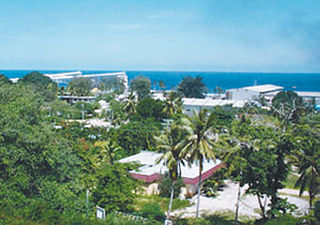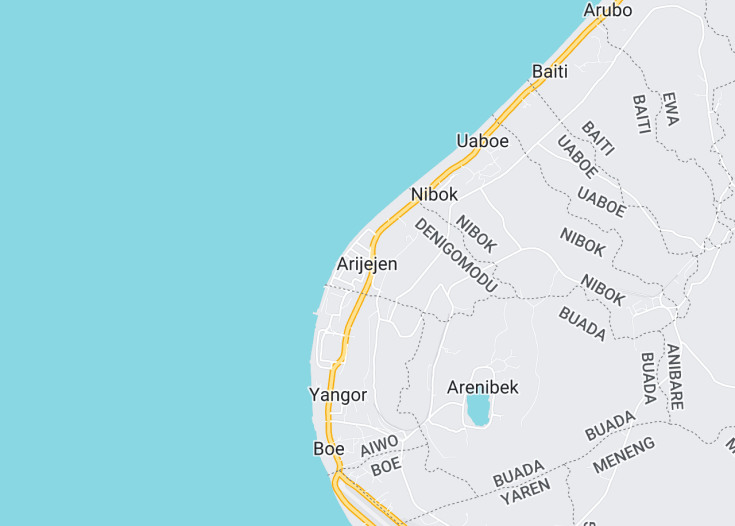Nauru, an island nation in Micronesia, offers breathtaking landscapes and cultural richness, with Arijejen standing out as a prime example. Lesser-known compared to other Pacific destinations, Arijejen presents a unique opportunity to explore untouched natural beauty and immerse in the tranquil pace of Nauru’s traditional lifestyle. This area showcases pristine beaches and the intriguing remnants of phosphate mining history, making it not only a scenic spot but also a portal into the island’s transformative journey from a booming mine to a serene getaway.
Ensure to bring sun protection and light clothing when visiting Arijejen, as the tropical climate can be quite warm and sunny year-round.
Consider visiting during the local dry season, from May to October, to make the most out of outdoor activities and explorations in Arijejen.
Top things to do & see in Arijejen
Select the following sights and activities to discover best tickets and tours available in Arijejen.
Arijejen: The Hidden Gem of the Pacific
| Country | Nauru |
| Time in Arijejen | GMT+12 |
| Language spoken | Nauruan |
| Population | 1,100 (2023 est.) |
| Currency | Australian Dollar (AUD) |
| Airports | Nauru International Airport (3 mi / 5 km). |
Arijejen, located in the heart of Nauru, is a quaint urban area with deep cultural traditions and immense natural beauty. Known for its welcoming community and scenic landscapes, Arijejenoffers a unique glimpse into the life on one of the world’s smallest islands. Historically, Arijejen has played a significant role in the local industry, predominantly in the phosphate mining sector, which has been the backbone of Nauru’s economy for decades.
Despite its small size, Arijejen retains a rich cultural heritage that is evident in its local customs, traditions, and festivities. The community here is tightly-knit, reflecting the overall societal structure of Nauru where family and community relations are highly valued. Visitors to Arijejenare often struck by the friendliness of its residents and the simplicity of life, providing a refreshing contrast to the hustle and bustle of larger cities.
Ecotourism is starting to gain traction in Arijejen, with initiatives aimed at preserving its pristine environments. The region is home to several endemic species of flora and fauna, and conservation efforts are in place to maintain the biodiversity of the area. The local government and community groups have been actively involved in promoting sustainable tourism practices that benefit both the environment and the local populace.
The culinary offerings in Arijejen are predominantly based on traditional Nauruan dishes, which often include fresh seafood, tropical fruits, and root vegetables. These dishes are a must-try for any visitor, offering a taste of the Pacific that is both exotic and delightful.
Where is Arijejen?
Arijejen is situated in the central part of Nauru, offering easy access to both the eastern and western coasts of the island.
Distances:
| Route | Distance by car | Time by car |
|---|---|---|
| Yaren to Arijejen | 0.6 mi (1 km) | 2 minutes |
| Meneng to Arijejen | 2.5 mi (4 km) | 8 minutes |
| Anabar to Arijejen | 4.2 mi (7 km) | 13 minutes |
What is Arijejen famous for?
Arijejen is renowned for being part of the phosphate mining industry, which significantly shaped the history and economy of Nauru. The community’s resilience and adaptation to modern challenges also add depth to its unique character.
History
Pre-1900: Ancient Beginnings and Tribal Dominance
The history of Arijejen, Nauru, stretches back thousands of years, marked by its settlement by Micronesian and Polynesian navigators. These early inhabitants organized themselves into twelve tribal units, which played a pivotal role in the communal and social structures of the island. Leadership was typically determined through matrilineal lines, a tradition that significantly shaped the political and social organization of Nauru, including Arijejen. Historically, these tribes engaged in fishing, small-scale agriculture, and the crafting of traditional artifacts.
1900-1947: The Phosphate Discovery and Colonial Rule
The discovery of phosphate in the early 20th century dramatically transformed Arijejen, like the rest of Nauru. This discovery drew the attention of colonial powers such as Germany, and later Australia, New Zealand, and the United Kingdom, under the Nauru Island Agreement. The extraction and exportation of phosphate brought significant economic changes to Arijejen, leading to the establishment of infrastructure but also to the exploitation and environmental degradation of the land, affecting the traditional lifestyles of its inhabitants.
1947-1999: Independence and Environmental Challenges
Post World War II marked a significant period for Arijejen as Nauru gained independence in 1968, becoming one of the richest countries per capita due to phosphate mining. However, the environmental repercussions of extensive phosphate mining began to manifest, leading to a drastic alteration in the landscape of Arijejen. The economic boom, initially a blessing, soon proved to be unsustainable without proper environmental management and planning, leading towards economic difficulties by the end of the 20th century.
2000-Present: Restoration and the Future
The focus in the 21st century has been largely on the restoration of the ecosystem and the diversification of the economy. Efforts to rehabilitate land areas previously used for mining are ongoing, with international aid and ecological strategies being implemented to restore biodiversity. Despite these efforts, the community of Arijejen faces challenges such as economic dependency on phosphate exports and the impacts of global climate change. The current initiatives aim to strike a balance between economic development and environmental sustainability, setting a pathway for future generations.
Visit Arijejen
What to see and do in Arijejen, Nauru
Visiting Arijejen offers a unique glimpse into the blend of natural beauty and historical depth. Noteworthy attractions include:
- The Central Plateau: Witness the stark landscape formed by decades of phosphate mining, now part of the island’s historical narrative.
- Command Ridge: The highest point in Nauruan which provides panoramic views of the island and historical remnants from World War II.
- Anibare Bay: Not far from Arijejen, this bay offers one of the most beautiful beaches in Nauru, ideal for relaxing and water sports.
- Traditional Craft Centers: Explore local workshops where traditional skills in weaving and crafting are preserved and taught.
Annual Events in Arijejen
Arijejen hosts several cultural events year-round, particularly vibrant during the Nauru Independence Day celebrations on January 31st. These include traditional music, dance performances, and sporting competitions, reflecting the rich cultural heritage of Nauru.
Best time to visit Arijejen
The ideal time to visit Arijejen is between May and October. During these months, the weather is more favorable, with less rainfall and lower humidity, making outdoor activities and exploration far more comfortable.
Is Arijejen worth visiting?
Arijejen, with its unique historical layers and natural scenery, presents a compelling destination. While it offers rich cultural experiences and natural attractions, potential visitors should be mindful of the environmental challenges and limited tourist infrastructure. Despite these issues, for those interested in Pacific Island history and culture, Arijejen offers a worthwhile, insightful experience, though it may best suit more adventurous travelers.









